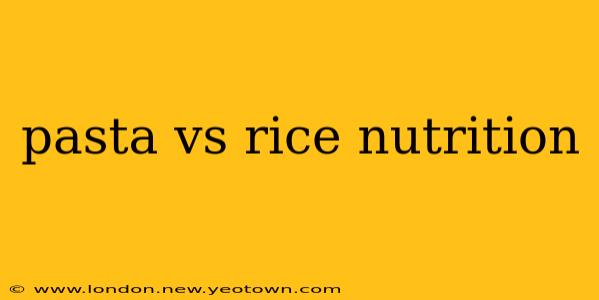The age-old question: pasta or rice? Both are carbohydrate staples in countless cuisines worldwide, providing energy and filling our plates. But when it comes to nutrition, which reigns supreme? The answer, as with most nutritional comparisons, isn't a simple "this one wins." It depends on the type, preparation method, and your individual dietary needs. Let's dive into a detailed comparison, exploring the nuances of these culinary cornerstones.
What are the nutritional differences between pasta and rice?
Our journey begins with a look at the core nutritional differences. Imagine two plates: one piled high with steaming pasta, the other brimming with fluffy rice. While both deliver carbohydrates, their composition varies subtly. Generally, pasta, particularly whole wheat varieties, boasts higher levels of fiber. Fiber aids digestion, promotes satiety (that feeling of fullness), and helps regulate blood sugar levels. Rice, on the other hand, depending on the type, can offer a more significant concentration of certain vitamins and minerals. Brown rice, for example, is a nutritional powerhouse, rich in magnesium and manganese. White rice, while refined and lacking much fiber, is easily digestible. The choice hinges on your dietary preferences and goals.
Is pasta or rice healthier?
The "healthier" option is not a black and white answer. Whole wheat pasta, with its higher fiber content and complex carbohydrates, generally edges out white rice in terms of nutritional value. However, brown rice significantly outperforms white rice and even holds its own against many whole wheat pasta varieties. Ultimately, the healthiest choice comes down to the specific type of pasta and rice you're comparing. Refined white pasta and white rice, while convenient and palatable, are less nutritionally dense than their whole-grain counterparts.
What type of pasta is the healthiest?
Choosing the healthiest pasta hinges on understanding the ingredients. Whole wheat pasta reigns supreme, offering a substantial fiber boost compared to its refined counterparts. Look for pasta made from 100% whole wheat; avoid blends containing refined flour. Explore options like lentil pasta or chickpea pasta for an even higher protein and fiber content. These alternatives offer a welcome boost in protein and micronutrients, making them excellent additions to a balanced diet.
What type of rice is the healthiest?
Similar to pasta, the nutritional value of rice varies widely. Brown rice, with its bran and germ intact, boasts a higher fiber, magnesium, and manganese content compared to white rice. Wild rice, known for its nutty flavor and slightly chewy texture, also offers an excellent nutritional profile. White rice, while convenient, lacks the fiber and nutrients found in its whole-grain counterparts.
Which one is better for weight loss?
Both pasta and rice can be incorporated into a weight-loss diet, but mindful choices are essential. The higher fiber content in whole wheat pasta and brown rice contributes to satiety, potentially aiding weight management by helping you feel fuller for longer. However, portion control remains crucial. Overconsumption of either, regardless of the type, can hinder weight loss efforts.
Which is better for diabetics?
For individuals with diabetes, the glycemic index (GI) matters. The GI measures how quickly a carbohydrate raises blood sugar levels. Whole-grain options generally have a lower GI than refined ones. Brown rice and whole wheat pasta typically have lower GI values compared to white rice and white pasta, making them better choices for managing blood sugar levels. However, always consult your doctor or a registered dietitian for personalized advice.
Are there any allergies associated with pasta or rice?
While relatively uncommon, some individuals experience allergies to wheat, a primary ingredient in many pasta types. Rice allergies are also possible, though less prevalent. Gluten-free pasta alternatives exist for those with wheat allergies. Individuals with rice allergies should seek alternative carbohydrate sources.
What are some healthy recipes using pasta and rice?
Pasta and rice provide versatile bases for countless healthy recipes. Whole wheat pasta pairs beautifully with vegetable-based sauces, lean protein sources (chicken, fish, beans), and a generous helping of fresh vegetables. Similarly, brown rice can anchor a flavorful bowl incorporating vegetables, tofu, or lean meats. The possibilities are limitless!
In conclusion, there's no single "winner" in the pasta vs. rice debate. The healthiest choice depends entirely on the specific type and how it's prepared. Opting for whole-grain options like whole wheat pasta and brown rice generally provides a more nutritious meal, offering greater fiber, vitamins, and minerals than their refined counterparts. Ultimately, a balanced and varied diet incorporating both in moderation, while focusing on whole-grain options, is a winning strategy for overall health and well-being.

